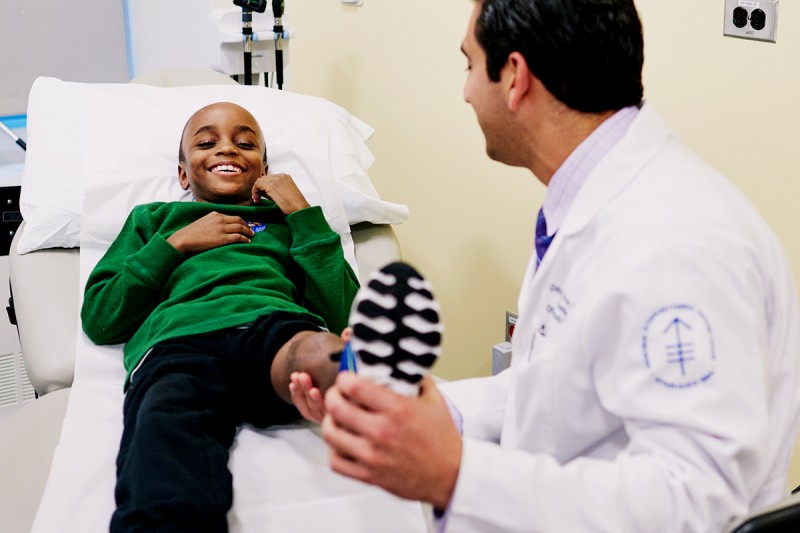
Taking Aim at Bone Cancer
As your care team plans the most-effective osteosarcoma care for your child, we consider whether the cancer has spread elsewhere in the body and also its grade.
- Children with low-grade tumors may only need surgery.
- Children with high-grade osteosarcoma may need surgery and chemotherapy. We often start with chemotherapy before surgery to shrink the tumor and kill any cancer cells elsewhere in the body. This is followed by surgery to remove the tumor, sparing or restoring the affected limb as much as possible.
Saving Lives, Preserving Life
At MSK Kids, we take every step we can to help children with bone and muscle tumors. We use limb-sparing operations whenever possible and advanced methods when amputation is needed.
We have one of the largest and most experienced pediatric orthopedic surgery programs in the world. Our surgeons combine their special training with compassion and understanding. Our goal is to give your child the best care possible. Learn more about orthopedic surgery at MSK Kids.
The World’s Pediatric Orthopedic Leaders Are at MSK Kids
Our multidisciplinary team of experts includes world leaders in pediatric orthopedic surgery. They have participated in and led Children’s Oncology Group clinical trials and committees to improve the futures of children with muscle and bone tumors. Our pediatric orthopedic surgeons have drafted the standards of care for pediatric bone tumors that are now followed by doctors all around the globe. They have also trained other pediatric orthopedic surgeons who are bringing the high level of MSK Kids care to other institutions.
Exceptional Patient Outcomes
MSK Kids pediatric orthopedic surgeons have subspecialty expertise, including in:
- joint replacement
- pelvic reconstruction
- hand surgery
- microsurgery
- and spine surgery.
They collaborate with medical oncologists, radiation oncologists, pathologists, interventional radiologists, nurses and nurse practitioners, physical and occupational therapists, social workers, and others who share a dedication to providing advanced, compassionate care to children with musculoskeletal tumors. Together, the team has achieved a very low rate of recurrence in children with osteosarcoma — just 3.5 percent, versus 13 to 14 percent elsewhere. When you bring your child to MSK Kids for treatment, you’re giving him or her the best chance of a successful outcome.
Personalizing Your Child’s Treatment
We customize your child’s care to his or her needs while considering future growth and development. Your team gets to know you and your child to learn what is most important to your family. Your child’s orthopedic surgeon tailors all treatment discussions to your child’s age and understanding, and takes his or her goals and preferences to heart. The doctor chooses the best surgical approach to create the most effective operation that minimizes the effects of the disease and its treatment on your child’s function and quality of life.
Who Do We Treat?
MSK Kids treats more young people with osteosarcoma and Ewing sarcoma than any other center in the country. Our pediatric orthopedic surgeons care for children with many other musculoskeletal cancers as well as noncancerous tumors and cysts, including:
- Rhabdomyosarcoma: a rare childhood cancer that begins in the muscles
- Fibrosarcoma in infants and children: a cancer that starts in the fibrous connective tissue at the ends of bones in the arms and legs
- Chondrosarcoma: a bone cancer composed of cartilage-producing cells
- Osteochondroma and other hereditary bone spurs (“exostoses”): common abnormal growths that form near the growth plates at the ends of long bones
- Chondroblastoma: a rare bone tumor that grows toward the ends of the long bones
- Hemangioma of the bones and soft tissues: a benign tumor made of blood vessels which we treat if it is causing discomfort or other symptoms
- Aneurysmal and unicameral (simple) bone cysts: blood- or fluid-filled sacs which we may treat with surgery and interventional radiology techniques to prevent bone damage
Limb-Preserving Surgery
At MSK Kids, our pediatric orthopedic surgeons do everything possible to preserve the bone where a tumor has developed. Our goal is to completely remove the tumor while maintaining the arm or leg and supporting your child’s ability to move and function freely. We do not perform amputation unless all other treatment options have been exhausted first.



